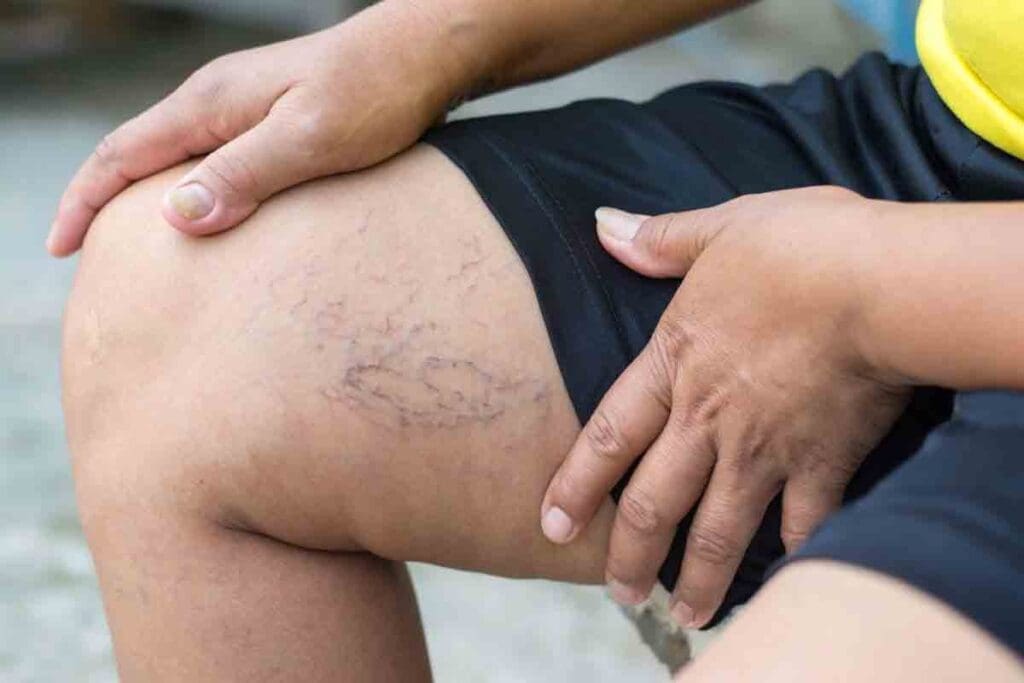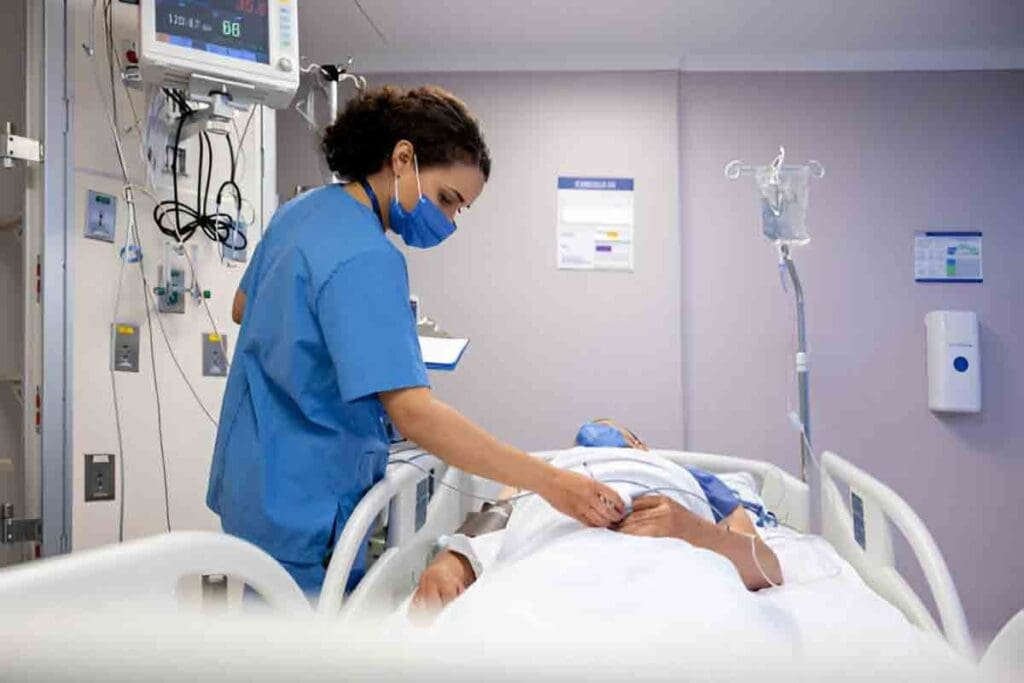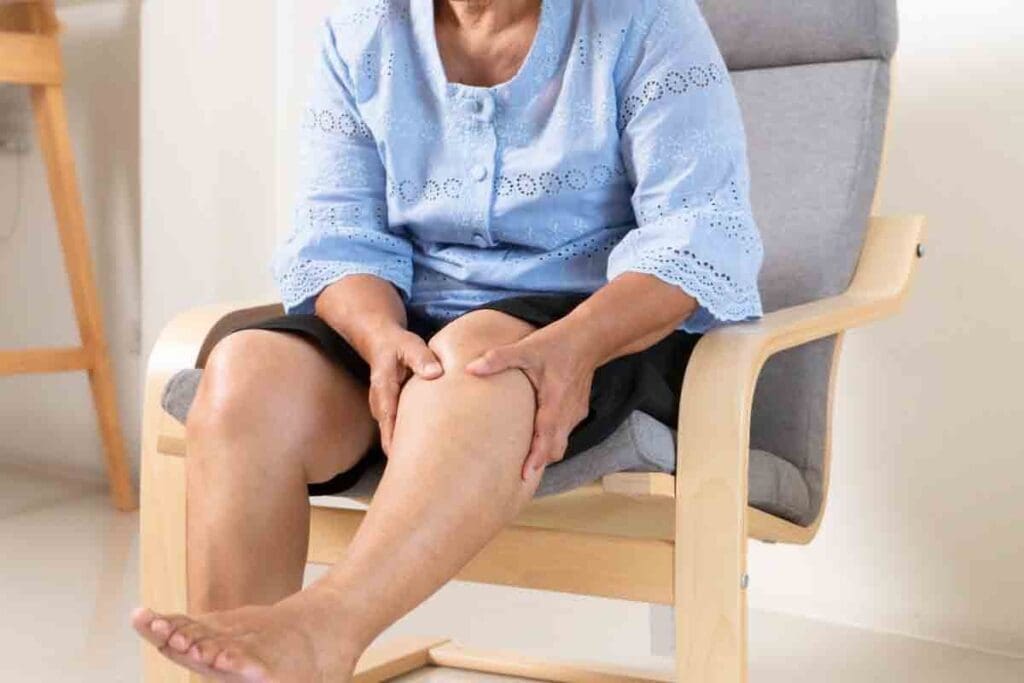Last Updated on November 17, 2025 by Ugurkan Demir

Deep vein thrombosis (DVT) is a serious condition where blood clots form in the deep veins of the legs. If left untreated, DVT can lead to life-threatening complications such as pulmonary embolism. Understanding the treatment options for DVT is key to effective management and prevention of further risks.Learn how to dissolve blood clots in legs. Follow this powerful treatment guide for a safe and crucial path to recovery and health.
At Liv Hospital, we stress the importance of quick medical attention for DVT. Our team of experts uses the latest treatment protocols to ensure the best outcomes for our patients. Treatment for DVT usually involves anticoagulant medications to prevent the clot from growing and to reduce the risk of further clots forming.

Blood clots in the legs are serious and often linked to Deep Vein Thrombosis (DVT). DVT happens when a blood clot forms in a deep vein, usually in the legs. Knowing the causes and risks of DVT is key to preventing and catching it early.
DVT is when a blood clot forms in a deep vein, often in the legs. This clot can block blood flow, causing swelling, pain, and serious risks if it travels to the lungs. This can lead to a pulmonary embolism.
Several factors can lead to blood clots in the legs. These include:
Knowing the risk factors for DVT is vital for prevention. Here’s a table of key risk factors:
| Risk Factor | Description |
| Age | Risk goes up with age, after 40 |
| Obesity | Being overweight or obese puts more pressure on the veins |
| Smoking | Smoking damages blood vessels and affects clotting |
| Cancer | Certain cancers and treatments can raise clotting risk |
By knowing these causes and risk factors, you can take steps to lower your chance of getting DVT.

Spotting DVT symptoms early is key to effective treatment and avoiding serious issues. DVT can show itself in many ways. Knowing these signs helps people get medical help when needed.
The first signs of DVT include leg pain or tenderness, swelling, and redness or discoloration in the leg. Some might feel a warmth or a feeling of heaviness in their leg. It’s important to remember that these signs can be different for everyone and might not always be there.
Not everyone will show all symptoms. Sometimes, DVT doesn’t show any symptoms at first. But as it gets worse, the symptoms will get stronger.
If you have severe leg pain or swelling, chest pain or trouble breathing, or coughing up blood, get help right away. These could mean a pulmonary embolism, a serious problem from DVT.
Also, if you’ve had DVT before, had surgery, been very inactive, or have a family history of blood clots, watch your symptoms closely. If anything seems off, get medical help.
Telling DVT apart from other leg issues can be hard because the symptoms are similar. Conditions like muscle strain, cellulitis, and varicose veins can look like DVT. To be sure, you need a doctor’s check-up, including an ultrasound and blood tests.
| Condition | Common Symptoms | Diagnostic Approach |
| DVT | Leg pain, swelling, redness | Ultrasound, blood tests |
| Muscle Strain | Pain with movement, localized tenderness | Physical examination, history |
| Cellulitis | Redness, swelling, warmth, fever | Physical examination, blood tests |
| Varicose Veins | Visible varicosities, aching legs | Physical examination, ultrasound |
Knowing the differences is key to the right treatment. If you’re unsure, always talk to a doctor for a correct diagnosis.
Diagnosing blood clots in the legs uses imaging and blood tests. These steps help find blood clots accurately. Deep Vein Thrombosis (DVT) diagnosis involves several steps.
Ultrasound is key to finding DVT. It’s non-invasive and shows blood vessels in real-time. This helps doctors see clots.
There are two main ultrasound types:
In some cases, Venography is used. It involves dye in the veins for X-ray images. But it’s less common because it’s invasive.
Blood tests are vital for diagnosing clotting disorders. The D-dimer test is common. It checks for protein fragments from dissolving clots. High levels suggest a clot.
But, this test isn’t always sure. It’s often used with other tests and clinical assessments
Other tests check for genetic clotting disorders. These include Factor V Leiden or Antithrombin III deficiency tests.
Expect a detailed medical history and physical exam during diagnosis. Doctors will look for symptoms and risk factors. They’ll also check for swelling or tenderness.
Knowing about diagnostic procedures can reduce anxiety. It’s important to follow your doctor’s advice and attend all tests for an accurate diagnosis.
The human body has a way to dissolve blood clots. This is key to getting blood flow back to normal. Blood clots aren’t permanent; the body can break them down over time.
The body breaks down clots through a process called fibrinolysis. This involves breaking down fibrin, the main clot component. An enzyme called plasmin does this job. It comes from plasminogen, which gets into the clot as it forms.
Plasmin is key in breaking down fibrin clots. It turns fibrin into smaller pieces. The switch from plasminogen to plasmin is controlled by activators and inhibitors. Tissue plasminogen activator (t-PA) is the main activator that helps break down clots.
Several things can help the body dissolve clots naturally. These include:
Knowing these factors can help people support their body’s natural clot dissolution process.
| Factor | Description | Benefit |
| Physical Activity | Regular movement and exercise | Improves circulation, aids clot dissolution |
| Compression Therapy | Use of compression stockings | Reduces swelling, improves blood flow |
| Adequate Hydration | Drinking enough water | Maintains blood fluidity |
Knowing how long it takes for blood clots to dissolve is key. It helps set patient expectations and plan treatments. The time it takes can change a lot. This depends on the clot’s size, where it is, and the person’s health.
Many things can change how long it takes for a blood clot to dissolve. These include:
It’s important to know if a clot is superficial or deep. Superficial clots near the skin’s surface dissolve faster. But deep vein thrombosis (DVT) in deeper veins needs more treatment and takes longer to heal.
The recovery time for DVT varies. But, here’s what usually happens:
Recovering from pulmonary embolism (PE) can be complex. Here’s what usually happens:
Knowing these timelines helps doctors manage patients and plan treatments well.
Medical treatments for blood clots in the legs aim to prevent complications and help dissolve clots. If you have Deep Vein Thrombosis (DVT), knowing your treatment options is key to managing it well.
Anticoagulants are the first choice for treating DVT. These medicines, known as blood thinners, stop the clot from growing and prevent new ones. They include:
A study in the New England Journal of Medicine found that anticoagulant therapy greatly lowers the risk of DVT and pulmonary embolism coming back.
“Anticoagulation is the cornerstone of treatment for DVT, aiming to prevent clot progression and recurrence.”
In severe DVT cases or when there’s a high risk of complications, more aggressive treatments are needed. Thrombolytic therapy, which dissolves clots with drugs, is one such option. But, it’s risky because it can cause bleeding and is usually for those with severe symptoms or at risk of limb ischemia.
| Treatment Option | Description | Risks/Benefits |
| Thrombolytic Therapy | Dissolves clots using drugs like alteplase. | High risk of bleeding; used in severe cases. |
| Catheter-Directed Thrombolysis | Delivers thrombolytic drugs directly to the clot via a catheter. | More targeted; reduces systemic bleeding risk. |
| Thrombectomy | Surgical removal of the clot. | Invasive; reserved for severe cases. |
Choosing the right treatment depends on several things. These include the clot’s size and location, the patient’s health, and the risk of complications. Healthcare providers use these factors to decide the best treatment for each patient.
Understanding DVT medical treatments helps patients make informed decisions about their care.
Anticoagulant therapy is key in treating deep vein thrombosis (DVT). Blood thinners, or anticoagulants, are vital. They stop blood clots from getting worse and lower the risk of serious problems.
Blood thinners stop the body’s natural clotting process. This lets the body dissolve the clot over time. They target different parts of the clotting process to reduce risks.
Many anticoagulant medications are used, each with its own benefits. Some common ones are:
Doctors choose these based on the patient’s DVT severity, kidney function, and drug interactions.
| Medication | Dosing Frequency | Monitoring Required |
| Warfarin | Daily | Yes (INR monitoring) |
| Rivaroxaban | Daily or twice daily | No |
| Apixaban | Twice daily | No |
| Dabigatran | Twice daily | No |
| Heparin | Continuous IV or twice daily (subcutaneous) | Yes (aPTT monitoring) |
The treatment length varies based on the patient’s risk and DVT cause. Treatment usually lasts 3 to 6 months, but can be longer for high-risk patients.
Many think blood thinners dissolve clots directly. But they actually stop new clots and let the body dissolve old ones. The body’s natural processes, with plasmin, break down the clot over time.
Understanding anticoagulant therapy helps patients make informed decisions. Working with healthcare providers is key to the best outcomes.
For those with life-threatening blood clots, thrombolytic therapy can be a lifesaver. We’ll look into how it works, its pros and cons, and who it’s for.
Clot-busting drugs, or thrombolytics, dissolve blood clots. They start the body’s natural clot breakdown process. Thrombolytic therapy is key for severe DVT and PE cases.
Thrombolytic therapy can save lives but comes with big risks, like major bleeding. We must weigh its benefits against these risks for each patient. Choosing thrombolytic therapy depends on the clot’s severity and the patient’s health.
Not every DVT or PE patient needs thrombolytic therapy. It’s mainly for severe or life-threatening clots. We assess each patient to see if this treatment is right for them.
Understanding thrombolytic therapy helps us see its life-saving role for severe blood clots.
Mechanical interventions are a good option for removing blood clots when medicine isn’t enough. These methods are key for dealing with tough or risky clots. They help get blood flowing again and stop more problems.
Catheter-directed thrombolysis is a small procedure that puts drugs right on the clot. It helps dissolve the clot better and lowers the chance of bleeding.
Benefits of Catheter-Directed Thrombolysis:
Thrombectomy removes the blood clot physically. There are different methods, like using devices to break or suck out the clot. These are used in emergencies or when there’s a big risk of clot complications.
| Thrombectomy Technique | Description | Clinical Use |
| Mechanical Thrombectomy | Uses devices to mechanically break up or remove the clot | Acute ischemic stroke, severe DVT |
| Aspiration Thrombectomy | Involves suctioning out the clot | Pulmonary embolism, large clots |
IVC filters are put in the vein that carries blood from the lower body to the heart. They stop blood clots from reaching the lungs by catching them.
Doctors use IVC filters for patients who can’t take blood thinners or have clots that keep coming back. But there’s debate about their use. The choice to put in an IVC filter depends on the patient’s situation, weighing the good against the bad.
Dealing with blood clots needs a mix of home care and lifestyle changes. As we recover, it’s key to use strategies that work with medical treatments. This helps us feel better overall.
Being active is key to DVT recovery. Try walking, cycling, or swimming to boost blood flow without straining your legs. Start with short, easy sessions and slowly increase them as your doctor advises.
Don’t stay in one place for too long. If you’re on bedrest or have a desk job, get up and stretch often. This helps prevent more clots and helps dissolve existing ones.
Eating right is important for dissolving blood clots. Omega-3-rich foods like salmon and flaxseeds reduce inflammation and improve blood flow. Also, eat foods high in antioxidants like berries and leafy greens for better vascular health.
Drink lots of water to keep blood flowing smoothly. This helps your body dissolve clots naturally. But if you’re on blood thinners, avoid foods high in vitamin K like leafy greens.
Compression stockings are a big help for DVT recovery. They reduce swelling and improve blood flow in your leg. They work by applying more pressure at the ankle and less as they go up, pushing blood towards the heart.
Always get advice from a doctor on how tight to wear them and for how long. Wearing them as directed can greatly aid in your recovery and prevent future problems.
While medical treatment is essential, some natural remedies can help too. Turmeric, for example, has anti-inflammatory properties that might be beneficial. But always talk to your doctor before trying new supplements, as they can interact with medications.
Stress-reducing activities like meditation or yoga can also help. They promote overall health, which is good for your blood vessels.
| Lifestyle Modification | Benefit for DVT Recovery |
| Regular Physical Activity | Improves circulation, reduces clot formation risk |
| Balanced Diet | Supports vascular health, aids in clot dissolution |
| Compression Therapy | Reduces swelling, enhances blood flow |
| Stress Reduction Techniques | Promotes overall well-being, supports recovery |
Managing blood clots means treating the clot and preventing complications. It’s important to know about possible issues and how to avoid them.
Bleeding is a big risk with blood thinners. We watch patients closely and adjust their meds as needed.
Pulmonary embolism (PE) is a serious risk with DVT. We make sure the clot doesn’t move to the lungs.
To stop PE, we use blood thinners and sometimes IVC filters.
Post-thrombotic syndrome (PTS) can happen after DVT. It causes chronic pain, swelling, and skin color changes. We check for PTS regularly.
| Symptom | Description | Action |
| Chronic Pain | Persistent pain in the affected limb | Manage with pain relief medication and compression therapy |
| Swelling | Swelling that persists or worsens over time | Use compression stockings and elevate the affected limb |
| Skin Discoloration | Changes in skin color or texture | Monitor for signs of skin ulcers and manage with wound care |
Knowing when to see a doctor is key during blood clot treatment. Call your doctor if you have:
By knowing about these complications and taking action, we can help people with blood clots get better.
Managing Deep Vein Thrombosis (DVT) is complex. It involves medical treatments, lifestyle changes, and prevention. We’ve looked at how to dissolve blood clots in the legs. This includes understanding causes and symptoms, and the treatment options available.
Summing up DVT treatment shows how key anticoagulants, thrombolytics, and mechanical methods are. Lifestyle changes, like staying active and eating right, help too. They support the body’s natural clot-dissolving process.
To conclude, treating blood clots in the legs needs both medical help and patient effort. Knowing about DVT and its treatments helps manage the condition. It also lowers the risk of serious problems. This approach ensures the best care for those with DVT.
The time it takes for a blood clot to dissolve varies. It depends on the clot’s size and location. Also, how well the treatment works. Generally, it can take weeks to months for a clot to dissolve.
Blood thinners, or anticoagulants, don’t dissolve clots directly. They stop new clots from forming and prevent existing ones from growing. This lets the body dissolve the clot naturally over time.
Recovery from Deep Vein Thrombosis (DVT) varies. Most people see big improvements in a few weeks to months with the right treatment.
The time for a pulmonary embolism to dissolve varies. But, with treatment, most dissolve in weeks to months.
Several factors affect how long it takes for blood clots to dissolve. These include the clot’s size and location, treatment effectiveness, overall health, and any underlying conditions.
The body can dissolve small blood clots naturally. But larger or more dangerous clots, like those in DVT, usually need medical treatment to avoid complications.
Thrombolytic therapy can quickly dissolve large or dangerous clots. But it also carries a risk of bleeding. The choice to use it depends on weighing these risks against the benefits for each patient.
Mechanical interventions, like catheter-directed thrombolysis and thrombectomy, can directly remove or dissolve clots. They’re used when anticoagulant therapy isn’t enough or suitable.
Yes, lifestyle changes can help. Regular exercise, dietary changes, and compression therapy support the body’s natural clot dissolution process and recovery.
To manage bleeding risks during anticoagulant treatment, monitor for signs of bleeding. Adjust medication dosages as needed. Be aware of interactions with other medications.
Plasmin is an enzyme that breaks down blood clots naturally. It dissolves the fibrin that holds the clot together.
Some natural remedies may support vascular health. But there’s little evidence they can directly dissolve blood clots. Always talk to a healthcare provider before using natural remedies, even if you’re already being treated for blood clots.
Subscribe to our e-newsletter to stay informed about the latest innovations in the world of health and exclusive offers!